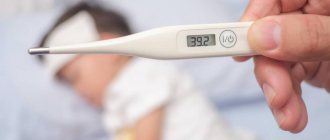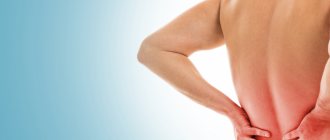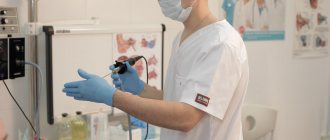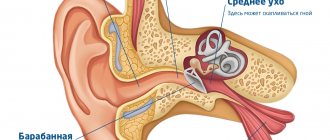Causes of pain in the navel area
Intestinal dyspepsia
Pain occurs when there are errors in the diet (the predominance of fatty, heavy foods), after heavy feasts with alcohol, under the influence of stress factors.
The pain syndrome is inconsistent and has moderate intensity. Patients describe their sensations as aching, pulling, stabbing. Pain in the navel area intensifies after eating, accompanied by heaviness and rumbling in the abdomen, diarrhea. Pain syndrome is characteristic of dyspepsia caused by food allergies. In this case, a feeling of discomfort in the navel area develops 1-2 hours after consuming a certain product. With severe sensitization of the body to the allergen, pain appears immediately after finishing the meal. Then nausea, vomiting, and diarrhea occur with the release of liquid stool of normal color.
Enzyme deficiency
Disorders of digestion (maldigestion) and absorption (malabsorption) of food in the small intestine are one of the most common causes of pain in the navel. Patients complain of constant discomfort, which intensifies 30-40 minutes after finishing a meal. Features of symptoms are determined by the type of enzyme deficiency:
- Lactase deficiency.
Pain syndrome is provoked by the intake of milk or dairy products containing lactose. There is moderate pain in the navel area, which is accompanied by rumbling in the abdomen and flatulence. The pain decreases slightly after defecation, during which liquid, foamy stool with a sour odor is released. - Exocrine pancreatic insufficiency.
Discomfort and pain do not depend on the composition of the food taken. I am worried about constant nagging pain in the abdominal cavity, which is localized near the navel, in the epigastrium and in the area of the left hypochondrium. The pain syndrome is combined with steatorrhea, creatorrhea, and lienterea.
Food poisoning
Unpleasant sensations develop in the peri-umbilical region due to food toxic infections, intestinal infections that occur as gastroenteritis, enterocolitis. Typical for poisoning are cramping pains near the navel, which appear suddenly and have varying intensity. They begin a few hours after eating low-quality foods or drinking water from unknown sources.
The symptom most often occurs with salmonellosis, for which the “triangle” is pathognomonic - pain in the epigastrium, around the navel and in the ileocecal zone. When pressing on the navel, a person feels sharp pain. Pain syndrome is also possible with other intestinal infections (escherichiosis, rotavirus gastroenteritis, yersiniosis). It is accompanied by repeated vomiting and diarrhea, dehydration.
Chronic enteritis
With chronic enteritis, minor pain and discomfort are constantly observed in the area surrounding the navel. Exacerbation of pain occurs under the influence of food and other provoking factors. The pain intensifies immediately after finishing eating, at the same time the urge to defecate appears. After the passage of gas and bowel movements, the pain subsides.
Pain in the navel area
Pathologies of the gastroduodenal region
With diseases of the stomach and duodenum, pain occurs not only in the epigastric region, but also around the navel. Severe hunger or night pain, relieved after eating, are characteristic of ulcers of the antrum and duodenal ulcers. With pyloric stenosis, complaints are made of bursting and dull pain, which subside after vomiting, but do not completely disappear. An attack of sharp pain in the epigastric and navel areas may be associated with volvulus or acute dilatation of the stomach.
Pancreatitis
Chronic pancreatitis is characterized by constant, low-intensity pain to the left of the navel, aggravated by eating large amounts of fatty and carbohydrate-rich foods. The symptom is accompanied by diarrhea; the stool contains pieces of undigested food. In acute pancreatitis, the patient experiences sharp girdling pain, affecting the peri-umbilical region and upper abdomen.
Umbilical hernia
In the initial stages of the disease, slight discomfort is felt near the navel, which intensifies when this area is compressed by tight clothing or a belt. As the hernia increases in size, a constant dull pain appears. A painless protrusion is formed in the area of the umbilical ring, which is easily reduced into the abdominal cavity. The complicated course of the hernia is indicated by severe pain attacks localized around the navel.
Diverticulosis
With inflammation of the diverticula of the small intestine, stabbing, aching, sharp pains around the navel develop. The sensations do not have a direct connection with meals, but can intensify after a heavy feast, when an increased load on the intestines is created. The pain syndrome is complemented by chronic diarrhea, which occurs 3-5 times a day and alternates with periods of normal stool.
Small bowel obstruction
Against the background of complete well-being, cramping pain occurs in the navel area. Its intensity periodically increases, which corresponds to the passage of a peristaltic wave. An early sign is vomiting of gastric contents, which after some time becomes fecal in nature. After 24-36 hours, the intensity of pain decreases, which serves as a prognostically unfavorable sign. A similar clinical picture is also typical for intestinal volvulus.
Appendicitis
In the first 2-3 hours of acute appendicitis, pain is felt near the navel. They have a cramping character, which does not change after changing body position or defecation. After the onset of pain, vomiting occurs once or twice. After a couple of hours, the pain shifts to the right iliac region. They are accompanied by weakness, pale skin, and increased body temperature.
Whipple's disease
Whipple's disease is characterized by paroxysmal pain around the navel, which occurs suddenly and is not associated with dietary factors. At the same time, diarrhea develops up to 10 times a day, nausea and vomiting. There is severe flatulence with colic-like or bursting pain in the center and sides of the abdomen. The pain syndrome is accompanied by arthralgia, febrile fever, and swollen lymph nodes.
Malignant tumors
Neoplasms of the small intestine manifest as pain in the navel area or to the left of it. The pain syndrome bothers the patient for several months, its intensity gradually increases. Over time, the umbilical pain becomes unbearable and standard painkillers do not respond to it. Malignant neoplasia is characterized by stool disorders, sudden weight loss, and signs of protein-energy deficiency.
Rare causes
- Pathologies of the urinary system
: horseshoe kidney, urachus cyst. - Vascular damage
: atherosclerosis of the abdominal aorta, mesenteric ischemia. - Hernias
: linea alba, Spigelian line.
Pain during pregnancy
In the first trimester, the uterus grows, the ligaments that attach it to the pelvic cavity stretch. These natural changes in a woman’s body during pregnancy are accompanied by mild pain. It should not cause concern either in the first trimester or in the last, when such sensations become harbingers of first training and then labor contractions. Worse, if bleeding occurs at the same time, then these are signs of the following conditions:
- Risk of miscarriage.
- Premature detachment of the chorion or placenta.
- Ectopic pregnancy.
Pain with bleeding after intercourse is a sign of cervicitis or cervical erosion.
Unhealthy sensations in the abdomen also occur during rough obstetric examinations, after which the uterus becomes excitable and tones. This state of the organ is determined by palpation or an ultrasound sensor, and is also indicated by pain during vaginal examination.
Hypertonicity
In emotionally unstable pregnant women, closer to childbirth, a condition called the pathological preliminary period occurs. The symptom of hypertonicity does not lead to labor, but is very exhausting. This is a periodically recurring cramping pain in the lower abdomen and lower back (severe and does not go away for a long time). Torment that lasts 6, 24 or 48 hours often ends in complications:
- Earlier outpouring of water.
- Weakness of labor.
- Fetal hypoxia.
Pain during pregnancy is dangerous when a squeezing lump is felt inside, as well as in the following cases:
- It is pulling, cramping or aching.
- Occurs in the evening, during rest, after light physical activity.
Diagnostics
During a physical examination, a gastroenterologist performs superficial and deep palpation, assesses areas of greatest pain, and pays attention to signs of impaired nutritional status. To identify the causes of pain in the navel area, laboratory and instrumental studies are prescribed. The diagnostic plan includes:
- Radiography
. Plain radiography of the abdominal cavity is informative for detecting signs of small bowel obstruction. X-ray examination with oral contrast is necessary to find ulcerative defects and diverticula. The technique provides an assessment of intestinal motor function. - Ultrasound diagnostics
. Ultrasound of the abdominal organs is a non-invasive way to visualize the anatomical and physiological features of the gastrointestinal tract. Using sonography, the doctor identifies signs of inflammatory damage to the pancreas, stomach or intestines. Duplex scanning is effective for assessing the condition of the abdominal aorta. - Endoscopic techniques
. The most informative method for examining the small intestine is video capsule endoscopy. It allows you to evaluate the structure of the mucosa, identify erosive and ulcerative defects, detect bulk neoplasms and signs of metaplasia. If the gastroduodenal area is affected, EGD is indicated. - Additional instrumental methods
. When large intestinal tumors are found, a CT or MRI must be performed to clarify their structure and the degree of involvement of surrounding tissues. Electrointestinography is indicated to determine intestinal motor activity. - Stool tests
. To evaluate the activity of digestive enzymes, a coprogram is used. Signs of pathology are the presence of striated muscle fibers, neutral fats, and starch grains. Intestinal inflammation is indicated by the content of mucus and leukocytes in the stool. If an intestinal infection is suspected, stool culture is recommended.
Pain in the navel area 1
Why does my stomach hurt?
There are two main types of abdominal pain: visceral and parietal.
The cause of visceral pain is irritation of the nerve endings in the walls of the internal organs, caused by their stretching or spasm. Such pain is also called colic, and its intensity is variable. However, it is often difficult to determine where the source of pain is located.
Parietal pain occurs due to irritation of the abdominal wall. This happens, for example, when a stomach ulcer is perforated. In this case, the abdominal muscles become significantly tense. Such pain, most often sharp and cutting, has a clearly defined center and is constant in nature.
Based on duration, abdominal pain is divided into chronic and acute. And if chronic ones can last a long time, then acute ones can last from several minutes to several hours. Acute pain indicates a sharp deterioration in health caused by various reasons. For example, this is how acute pancreatitis, cholecystitis and ulcers manifest themselves.
Treatment
Help before diagnosis
Functional dyspeptic disorders can be successfully corrected by changing diet and lifestyle. If pain at the navel is combined with loose stools, you need to temporarily eliminate dairy products, fatty foods, and dishes with artificial sweeteners. The diet should consist of grain crops, stewed or boiled vegetables, lean meat and fish in moderation. It is important to avoid stressful activities.
If there are signs of food poisoning, first aid includes gastric lavage, if you have recently consumed low-quality food, and taking sorbents. It is necessary to drink more liquid (water, unsweetened dried fruit compote) to prevent dehydration of the body. With severe umbilical spasms and a sharp deterioration in health, the patient needs emergency medical care.
Conservative therapy
The treatment regimen is selected after identifying the root cause of peri-umbilical pain syndrome. Treatment is mainly carried out on an outpatient basis. Hospitalization is required for exacerbation of a chronic disease, a possible acute surgical condition, or severe dehydration. In gastroenterology, the following groups of drugs are used for pain in the peri-umbilical region:
- Enzymes
. Preparations of pancreatic enzymes improve digestion processes, eliminate the phenomena of malabsorption, due to which the pain syndrome disappears. For some combined pathologies of the intestines and stomach, in addition to enzymes, gastric juice is recommended. - Antispasmodics
. Most episodes of pain in the navel area are associated with spastic contractions of the intestines, which are successfully relieved by drugs with antispasmodic effects. For severe pain, analgesics are taken. - Probiotics
. Medicines normalize intestinal microflora and prevent bacterial overgrowth syndrome (SIBO). They are effective for a combination of pain and dyspeptic symptoms. To enhance the effect of probiotics, they are supplemented with prebiotics. - Antidiarrheal drugs
. For chronic diarrhea that is not corrected with diet, medications of the loperamide group are prescribed. They normalize gastrointestinal motility, slow down the movement of feces, and eliminate excessive peristaltic contractions and associated pain in the abdominal area.
The doctor selects a balanced diet that must be followed to prevent exacerbations of the disease. During the period of remission of chronic diseases, drinking mineral waters, physiotherapy methods, and sanatorium-resort treatment are recommended. In case of severe functional disorders of the gastrointestinal tract, it is advisable to conduct psychotherapy, which is aimed at eliminating the effects of stress factors.
Surgery
Pain in the navel area can be caused by surgical pathologies (appendicitis, intestinal obstruction), for which urgent surgical treatment is indicated. For uncomplicated forms of diseases in abdominal surgery, laparoscopic surgical techniques are used. Small intestinal obstruction and destructive forms of appendicitis require open surgery by laparotomy.
For hernias, various methods of hernioplasty are performed using mesh allografts and the patient’s own tissue to close the umbilical ring defect. Treatment of oncological processes involves an extended operation with resection of a section of the intestine and surrounding tissues as a single block, after which an intestinal anastomosis is formed or an enterostomy is removed.
When to call a doctor
{banner_banstat9}
Fever and mild abdominal pain
- a reason to call a therapist at home. The reason for the arrival of an ambulance is severe, excruciating pain, which is accompanied by the following additional symptoms:
- Tight abdominal muscles.
- Urinary retention.
- Blood in vomit, feces, urine.
- Excrement in black.
- Temperature 38 °C and above.
- Uterine bleeding.
While waiting for the ambulance to arrive, you cannot take any medications, apply heating pads, or eat or drink. It is better to lie in a comfortable position and not make sudden movements.











